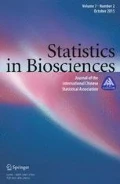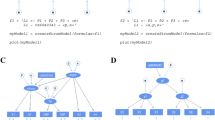Abstract
Variance-component methods are popular and flexible analytic tools for elucidating the genetic mechanisms of complex quantitative traits from pedigree data. However, variance-component methods typically assume that the trait of interest follows a multivariate normal distribution within a pedigree. Studies have shown that violation of this normality assumption can lead to biased parameter estimates and inflations in type-I error. This limits the application of variance-component methods to more general trait outcomes, whether continuous or categorical in nature. In this paper, we develop and apply a general variance-component framework for pedigree analysis of continuous and categorical outcomes. We develop appropriate models using generalized-linear mixed model theory and fit such models using approximate maximum-likelihood procedures. Using our proposed method, we demonstrate that one can perform variance-component pedigree analysis on outcomes that follow any exponential-family distribution. Additionally, we also show how one can modify the method to perform pedigree analysis of ordinal outcomes. We also discuss extensions of our variance-component framework to accommodate pedigrees ascertained based on trait outcome. We demonstrate the feasibility of our method using both simulated data and data from a genetic study of ovarian insufficiency.
Similar content being viewed by others
References
Abecasis GR, Cardon LR, Cookson WOC (2000) A general test of association for quantitative traits in nuclear families. Am J Hum Genet 66:279–292
Allen EG, Sullivan AK, Marcus M, Small C, Dominguez C, Epstein MP, Charen K, He W, Taylor KC, Sherman SL (2007) Examination of reproductive aging milestones among women who carry the FMR1 premutation. Hum Reprod 22:2142–2152
Allison DB, Neale MC, Zannolli R, Schork NJ, Amos CI, Blangero J (1999) Testing the robustness of the likelihood-ratio test in a variance-component quantitative-trait loci-mapping procedure. Am J Hum Genet 65:531–544
Almasy L, Blangero J (1998) Multipoint quantitative-trait linkage analysis in general pedigrees. Am J Hum Genet 62:1198–1211
Amos CI (1994) Robust variance-components approach for assessing genetic linkage in pedigrees. Am J Hum Genet 54:535–543
Blangero J, Williams JT, Almasy L (2001) Variance component methods for detecting complex trait loci. In: Rao DC, Province MA (eds) Genetic dissection of complex traits. Academic Press, San Diego, pp 151–182
Breslow NE, Clayton DG (1993) Approximate inference in generalized linear mixed models. J Am Stat Assoc 88:9–25
Burton PR, Tiller KJ, Gurrin LC, Cookson WO, Musk AW, Palmer LJ (1999) Genetic variance components analysis for binary phenotypes using generalized linear mixed models (GLMMs) and Gibbs sampling. Genet Epidemiol 17:118–140
Burton PR, Palmer LJ, Jacobs K, Keen KJ, Olson JM, Elston RC (2000) Ascertainment adjustment: where does it take us? Am J Hum Genet 67:1505–1514
de Andrade M, Fridley B, Boerwinkle E, Turner S (2003) Diagnostic tools in linkage analysis of quantitative traits. Genet Epidemiol 24:302–308
de Andrade M, Gueguen R, Visvikis S, Sass C, Siest G, Amos CI (2002) Extension of variance components approach to incorporate temporal trends and longitudinal pedigree data analysis. Genet Epidemiol 22:221–232
Diao G, Lin DY (2005) A powerful and robust method for mapping quantitative trait loci in general pedigrees. Am J Hum Genet 77:97–111
Duggirala R, Blangero J, Almasy L, Dyer TD, Williams KL, Leach RJ, O’Connell P, Stern MP (1999) Linkage of type 2 diabetes mellitus and of age at onset to a genetic location on chromosome 10q in Mexican Americans. Am J Hum Genet 64:1127–1140
Duggirala R, Williams JT, Williams-Blangero S, Blangero J (1997) A variance component approach to dichotomous trait linkage analysis using a threshold model. Genet Epidemiol 14:987–992
Epstein MP (2002) Comment on “Ascertainment adjustment in complex diseases”. Genet Epidemiol 23:209–213
Epstein MP, Lin X, Boehnke M (2002) Ascertainment-adjusted parameter estimates revisited. Am J Hum Genet 70:886–895
Epstein MP, Lin X, Boehnke M (2003) A tobit variance-component method for linkage analysis of censored trait data. Am J Hum Genet 72:611–620
Fulker DW, Cherny SS, Cardon LR (1995) Multipoint interval mapping of quantitative trait loci using sib pairs. Am J Hum Genet 56:1224–1233
Glidden DV, Liang K-Y (2002) Ascertainment adjustment in complex diseases. Genet Epidemiol 23:201–208
Haseman JK, Elston RC (1972) The investigation of linkage between a quantitative trait and a marker locus. Behav Genet 2:3–19
Hasstedt SJ (1993) Variance components/major locus likelihood approximation for quantitative, polychotomous, and multivariate data. Genet Epidemiol 10:145–158
Hopper JL, Mathews JD (1982) Extensions to multivariate normal models for pedigree analysis. Ann Hum Genet 46:373–383
Hunter JE, Epstein MP, Tinker SW, Charen KW, Sherman SL (2008) Fragile X-associated primary ovarian insufficiency: evidence for additional genetic contributions to severity. Genet Epidemiol 32:553–559
Jacquard A (1974) The genetic structure of populations. Springer, New York
Kruglyak L, Daly M, Reeve-Daly M, Lander E (1996) Parametric and nonparametric linkage analysis: a unified multipoint approach. Am J Hum Genet 58:1347–1363
Kruglyak L, Lander ES (1995) Complete multipoint sib-pair analysis of qualitative and quantitative traits. Am J Hum Genet 57:439–454
Lander ES, Green P (1987) Construction of multilocus genetic linkage maps in humans. Proc Natl Acad Sci USA 84:2363–2367
Lange K (1978) Central limit theorems for pedigrees. J Math Biol 6:59–66
Lange K, Boehnke M (1983) Extensions to pedigree analysis. IV. Covariance components models for multivariate traits. Am J Med Genet 14:513–524
Lange K, Westlake J, Spence MA (1976) Extensions to pedigree analysis. III. Variance components by the scoring method. Ann Hum Genet 39:485–491
Lin X (1997) Variance component testing in generalised linear models with random effects. Biometrika 84:309–326
McCullagh P (1980) Regression models for ordinal data. J R Stat Soc, Ser B 42:109–142
McCullagh P, Nelder JA (1983) Generalized linear models. Chapman and Hall, London
McCulloch CE, Searle SR (2000) Generalized, linear, and mixed models. Wiley-Interscience, New York
Mitchell BD, Ghosh S, Schneider JL, Birznieks G, Blangero J (1997) Power of variance component linkage analysis to detect epistasis. Genet Epidemiol 14:1017–1022
Murray A, Webb J, MacSwiney F, Shipley EL, Morton NE, Conway GS (1999) Serum concentrations of follicle stimulating hormone may predict premature ovarian failure in FRAXA premutation women. Hum Reprod 14:1217–1218
Pankratz VS, de Andrade M, Therneau TM (2005) Random effects Cox proportional hazards model: general variance components methods for time-to-event data. Genet Epidemiol 28:97–109
Pinheiro JC, Bates DM (1995) Approximations to the log-likelihood function in the nonlinear mixed-effects model. J Comput Graph Stat 4:12–35
SAS Institute (1999) SAS version 8, Cary, NC
Self SG, Liang K-Y (1987) Asymptotic properties of maximum likelihood estimators and likelihood ratio tests under non-standard conditions. J Am Stat Assoc 82:605–610
Sham PC, Purcell S (2001) Equivalence between Haseman–Elston and variance-components linkage analyses for sib pairs. Am J Hum Genet 68:1527–1532
Sherman SL (2000) Premature ovarian failure in the fragile X syndrome. Am J Med Genet 97:189–194
Sherman S, Pletcher BA, Driscoll DA (2005) Fragile X syndrome: diagnostic and carrier testing. Genet Med 7:584–587
Solomon PJ, Cox DR (1992) Nonlinear component of variance models. Biometrika 79:1–11
Spiegelhalter D, Thomas A, Best N (2000) WinBUGS version 1.3 user manual. MRC Biostatistics Unit, Cambridge, UK
Sullivan AK, Marcus M, Epstein MP, Allen EG, Anido AE, Paquin JJ, Yadav-Shah M, Sherman SL (2005) Association of FMR1 repeat size with ovarian dysfunction. Hum Reprod 20:402–412
Tierney L, Kadane JB (1986) Accurate approximations for posterior moments and marginal densities. J Am Stat Assoc 81:82–86
Williams JT, Blangero J (1999) Comparison of variance components and sibpair-based approaches to quantitative trait linkage analysis in unselected samples. Genet Epidemiol 16:113–134
Yu X, Knott SA, Visscher PM (2004) Theoretical and empirical power of regression and maximum-likelihood methods to map quantitative trait loci in general pedigrees. Am J Hum Genet 75:17–26
Zeger SL, Karim MR (1991) Generalized linear models with random effects: a Gibbs sampling approach. J Am Stat Assoc 86:79–86
Author information
Authors and Affiliations
Corresponding author
Rights and permissions
About this article
Cite this article
Epstein, M.P., Hunter, J.E., Allen, E.G. et al. A Variance-Component Framework for Pedigree Analysis of Continuous and Categorical Outcomes. Stat Biosci 1, 181–198 (2009). https://doi.org/10.1007/s12561-009-9010-5
Received:
Accepted:
Published:
Issue Date:
DOI: https://doi.org/10.1007/s12561-009-9010-5



